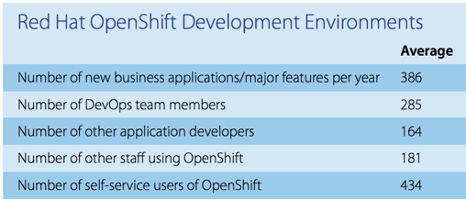
According to an IDC study, Red Hat OpenShift brings lots of advantages to the companies, especially in terms of productivity, revenue and costs. Let’s analyse the business value found by the interviewed companies and let’s understand why your company should adopt this Platform-as-a-Service solution too.
The digital revolution took a lot of unexpected competition between companies, so the IT departments have to react and answer the business and customers’ needs faster than before. This is one of the reasons why the IT companies are evolving, adopting a new approach based on innovative systems to help developers becoming more efficient than ever.
The applications platforms supporting a type of architecture that gives developers a wide choice of components through a hybrid cloud infrastructure, represent a preferred embodiment during the cloud adoption journey. To prove this, IDC interviewed 9 organizations using Red Hat OpenShift as the first platform for the applications’ development. They all confirmed the advantages of using OpenShift because it helps them everyday delivering applications and functionalities in a very fast way, even in complex IT environments supporting key IT initiatives like containerization, microservices and cloud migration strategies.
OpenShift platform is giving high value to all its customers, estimating 1,29 million dollars per year in a 5 years perspective with a team of 100 members. To resume the advantages revealed by the survey, we can affirm that OpenShift:
- Helps developers delivering high-quality applications and functionalities in a faster way;
- Improves business and efficiency results satisfying the customers’ and users’ needs;
- The continuous application management needs less time;
- Reduces the applications’ developed costs associated to the infrastructure and platforms’ development.
What are the Platform-as-a-Service and Red Hat OpenShift?
The application platforms based on the development and DevOps practices, are bringing lots of benefits to companies that are facing the digital transformation journey. IDC affirms that the cloud application platforms are the basis of the Platform-as-a-Service, a platform that uses a large amount of cloud services to abstract the application development complexity.
As the applications’ request increases, the main business driver for the PaaS solutions is the agility with which developers can turn the ideas into concrete value for the users.
Red Hat OpenShift Container Platform provides a set of open source tools based on container technology that enable the digital transformation process, accelerate the application development and optimize the use of the infrastructure.
OpenShift is available in two versions: public or private. In the first case the application development, creation, implementation and hosting are on the cloud, in the second one it is possible to implement it both as a private cloud or on-premise.
With OpenShift it is possible to implement distributed, advanced and scalable services based on the Docker container technology and orchestrated by Kubernetes. They combine then the applications together with the files they depend to, making the production and development environments more uniform and simplifying the applications’ distribution.
Moreover, any application written using OpenShift can be developed also outside that environment that supports the same languages, giving developers the opportunity to easy shift avoiding the vendor lock-in and allowing possible future migrations in the development environment.
The IDC study
IDC interviewed 9 organizations using RedHat OpenShift platform in production to understand the impact on the application development process and the related services, on the business results and the IT costs. The analysed companies belong to different countries and vertical sectors and they can be small companies with less than 100 employees or large companies with more than 100.000 employees and with lots of headquarters all over the world.
The reasons why they choose Red Hat OpenShift
Customers that chosen to adopt OpenShift came from different legacy environments, including providers’ platforms and homemade tools, with which was very difficult to achieve agility, scalability and quality. In OpenShift they found an open source solid and flexible development platform supporting also important high-level IT initiatives like the migration to the hybrid public cloud, containerization and microservices.
Red Hat OpenShift operative benefits
The use of OpenShift by the interviewed organizations shows their internal IT environments heterogeneity and the necessity of a platform able to support various initiatives and technologies. 8 out of 9 of them use OpenShift especially in virtualized environment, or more precisely in public cloud and OpenStack environments.
They all demonstrate that OpenShift supports containerization, DevOps and the private cloud initiatives. 8 of them affirm they are using much more microservices than before.
The following table shows that more than 650 DevOps and applications’ developers are developing an average of 386 new applications and other important functionalities per year. With such a high activity, it is fundamental to have a strong, solid and reliable development platform.

The Business Value generated by Red Hat OpenShift
Thanks to the Platform-as-a-Service, companies noticed a huge value in terms of more productivity of the application development and DevOps teams, increasing revenue and reducing costs.
IDC estimated that in the next years most benefits will involve the following areas:
- IT staff productivity: Application developers and DevOps teams are able to develop more application and functionalities needing less time to dedicate to the OpenShift Platform, increasing the company’s productivity. The applications developed using OpenShift will need less management time also during the production phase.
- Company productivity: OpenShift satisfies the need of high quality and functional applications and business services.
- IT infrastructure costs reduction: developing on an OpenShift platform needs less servers for the testing and the production phases because of the containerization, microservices and multitenancy support.
- Reduction of the users’ productivity risk: the applications developed on an OpenShift platform show less disruptions, improving the production times.
Here below you can find some data resuming the Business benefits found by the interviewed companies:
- 531% of the mean ROI in 5 years
- 66% increase in application development lifecycle velocity
- 35% reduction in time for each application developed
- 35% reduction in costs of the development platform and the IT infrastructure for each application
As the metrics show, by using OpenShift, developers are able to provide more applications and functionalities in less time. The interviewed organizations say that each new application developed needs, on average, the 35% less time of work.
If you want to know everything about all the DevOps tools, we suggest you download our FREE GUIDE:








